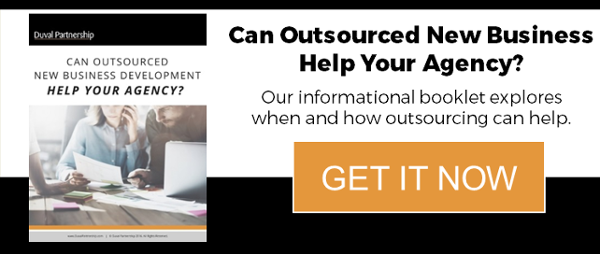Have you ever wondered why you failed to convert a call or meeting into new business? If so, this post is for you.
 In the past, I’ve written about how to have more effective prospect conversations, how to make the most of prospect meetings, and how agencies botch prospect meetings. In those posts, I addressed pre-meeting preparation, questioning strategy, and things you should and shouldn’t do in the meeting to make a good impression. This post is going to complete the loop, covering the period from new business meeting to post-meeting follow-up and how to close new business after a meeting.
In the past, I’ve written about how to have more effective prospect conversations, how to make the most of prospect meetings, and how agencies botch prospect meetings. In those posts, I addressed pre-meeting preparation, questioning strategy, and things you should and shouldn’t do in the meeting to make a good impression. This post is going to complete the loop, covering the period from new business meeting to post-meeting follow-up and how to close new business after a meeting.
Assuming that the pre-meeting groundwork has been laid and you go into the meeting prepared, perhaps the most important factor is correctly understanding the point of the meeting.
Why are we here?
Here are some ways agencies often misperceive the purpose of the meeting:
- Thinking it’s a “me show” and using it as a vehicle to “dazzle” the prospect and show off the agency’s creative ideas
- Thinking that the meeting itself is the key goal point
- Thinking that because the meeting’s been secured that “it’s in the bag,” and proceeding to close is but a formality
- Interpreting the meeting to mean that business is available at that moment and is theirs for the taking, like fruit just waiting to be plucked
Here are better ways to look at the point of the meeting:
- An important but early-stage step on the path to securing future business
- A diagnostic meeting to understand the client’s challenges—and IF and HOW you might be able to help them find solutions
- A chance to confirm whether their stated challenges are the true root cause of their pain
- An introduction to become a potential resource and hopefully build a relationship, in the near or long term
- A venue to get the information you need to prepare a thoughtful, customized proposal that will lay out strategic solutions to their identified challenges
- An opportunity to illustrate your agency’s credibility, providing proof points and showing business results
- The beginning of a discovery process and a chance to make the prospect think, challenging them to look at things in new ways through thoughtful, strategic questions
Why does this matter?
If your agency approaches meetings with the wrong mindset, you will end up wasting an important opportunity. The meeting is the beginning of a long process, not an end goal and certainly not a formality. There may be no business to be had in the near-term, due to budget constraints or existing relationships. That’s not a bad thing; new business will still be welcome in 12 months, but you want to correctly understand the opportunity and what you need to do between now and then in order to close it (or drop it). Using your qualification questions and strategic questioning, you can determine whether this prospect is a good fit for your agency, and what is required on your part to close the account. But you can’t do that if you just came to “dazzle.”

Your first meeting with a prospective client forms the basis of their impressions about what it would be like to work with your agency. If you miss the opportunity to show them that you “get” them, and want to “get” them better by asking thoughtful questions, then it reflects poorly on your abilities as a potential partner. By all means, dig in, show interest in their business and unique challenges, confirm the underlying problems and diagnosis, start to think about solutions, and provide evidence that you are capable of providing those solutions. This is, after all, the beginning of a discovery process. You and the prospect should be evaluating each other for potential fit, based not only on personalities and culture, but also on bottom-line results, experience, perspective, potential value, and capabilities.
Come prepared with the necessary tools to embark on your discovery process:
- Questioning strategy
- A clear meeting agenda and plan
- Research done on the meeting attendees, prospect company, their industry, and their competitors
- Equal business stature
- Evidence of your prior results that are relevant to their industry and challenges
What about the dazzle?
When it comes to showing your agency’s work in this meeting, the point is not the creative itself. There should be no showcase of standalone creative. The goal is to demonstrate to the prospect that your agency has the credibility and business expertise to deliver solutions to their problems. So creative work is shown in the context of providing proof of your strategy and results in their industry, with their challenges, etc. It should be clear to the prospect why they would use you versus another agency, what problems you can solve, how you help, and what results you can get for them.

Approaching a prospect meeting as an opportunity for discovery — while demonstrating the business value of your work as a tool to solve their challenges — will yield an entirely different outcome than approaching it as an opportunity to show off your agency’s sizzle reel while hoping to secure new business through dazzle and charm.
Preparing for the next steps
So many agencies are focused on getting in the room as the end goal that they have no plan for when the meeting is over. But the actual selling and providing the real value and business expertise begins after the meeting.
It’s important to have a clear follow-up plan for after the meeting, through which you will reinforce your agency’s ability to provide solutions to the prospect’s challenges. The alternative is relying on hope that you might be magically awarded the business, which is no plan at all.
If you have employed strategic questioning throughout the meeting, you should have something to work with when clarifying the post-meeting steps. Here are some examples of things you might say to get the prospect’s buy-in on next steps at the close of the meeting:
- Make room for anything overlooked: “Of all the things we’ve discussed so far, what am I missing, what have we left out?”
- Confirm your understanding: “I understand that X, Y, and Z are the most pressing challenges and pain points for you right now, would you agree?”
- Gauge their time frame and degree of interest: “You said that you need X, Y, and Z; if we are able to offer solutions to these challenges of yours, are you ready to move forward with this opportunity and embark on a project?”
- Pin down the next step: “Let us go and put together some solutions around these unique challenges you are facing, and let’s meet here again next Thursday at 3 p.m.”
By the end of the meeting, there are three likely outcomes:
-
There is not a mutual fit and you can agree to go your separate ways, not wasting additional time. In this case, the best scenario may be to keep this introduction in mind for future potential opportunities, referrals, and networking, but you won’t be devoting additional new business resources to closing the opportunity. Depending on the context, it may be appropriate to add them to a low-key lead nurturing campaign where they might receive updates on your agency at a few points throughout the year.
-
There is a mutual fit but not an immediate need or opportunity. In this case, you definitely want to plan a lead nurturing program that will continue to demonstrate your agency’s expertise and credibility as a resource. That may include personal invitations to grab a coffee or attend an event, as well as one-to-one personalized emails. You also want to be sure that you have a ballpark time frame from them for when it would be appropriate to circle back regarding the potential opportunity. For example, if their marketing budget is allocated for the year, or they are tied to a contract for a defined period of time, when will the new budget be decided; when will that contract be up for review?
-
There is a mutual fit and an immediate need or opportunity. This is the best case scenario. You would proceed to develop a proposal and set up a follow-up meeting (typically within a week or two), at which time you would discuss the proposal and potential solutions to the prospect’s challenges. If you have a clearly-defined road map — informed by your discovery questions and the opportunity — after the initial meeting you can put together a compelling, customized proposal. Don’t make the mistake of sending your proposal via email. Insist on walking through it together, either in person or via virtual meeting, so that you can ask and answer any questions at that time, and make adjustments as needed.
Follow these steps, and you’ll find you are much more likely to close new business after initial prospect meetings.
Read more:
- Tips to Make the Most of Your Next Prospect Meeting
- How to Have More Effective Conversations with Agency Prospects
- Agency New Business: Questioning Strategy & Tips
- 6 Ways Agencies Botch Prospect Meetings
Image credits: fail to close new business © Adobe Stock/ Africa Studio, gauge mutual fit © Adobe Stock/ C.Schubler, agency dazzle © Adobe Stock/ Jacob Lund



